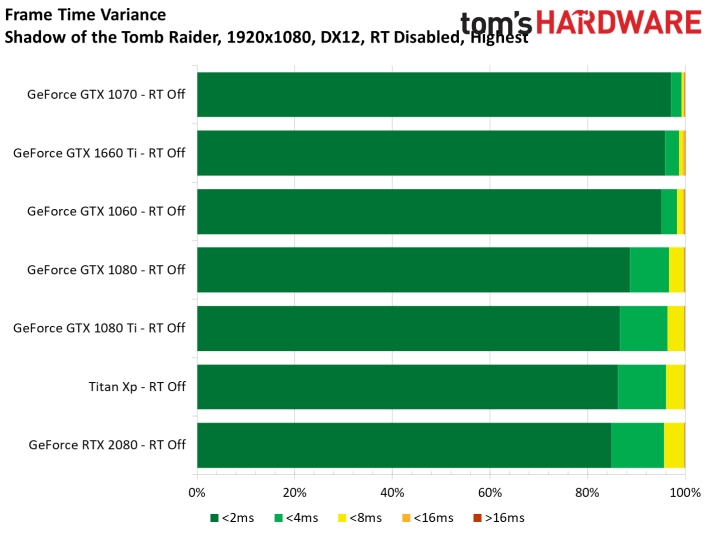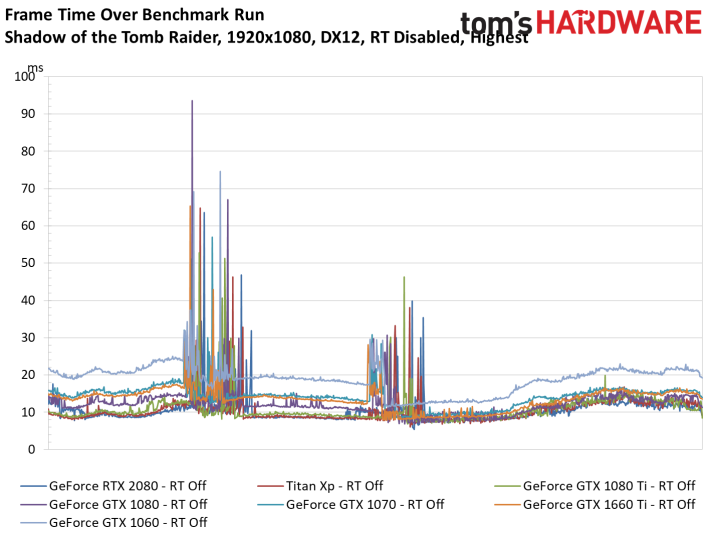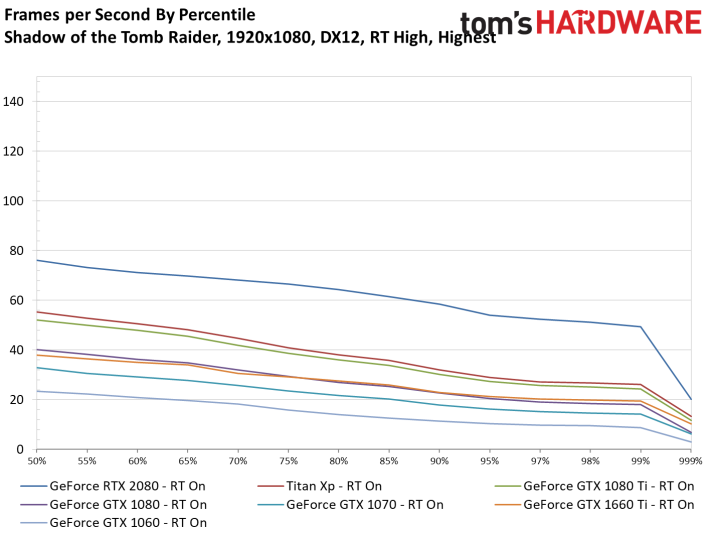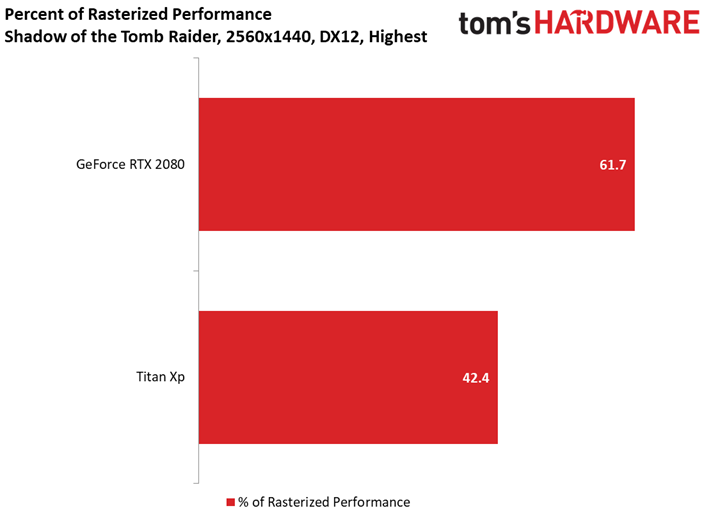Ray Tracing On Nvidia’s Pascal Architecture, Benchmarked
Shadow of the Tomb Raider: Ray-Traced Shadows
Shadow of the Tomb Raider: Ray-Traced Shadows
Nvidia is also forthcoming in its description of how Shadow of the Tomb Raider utilizes ray tracing (namely, ray-traced shadows).
“There are five types [of ray-traced shadows you can enable], and they all improve shadow realism and detail... Point Light Shadows: Point lights, like light bulbs and candles, emit light in all directions. The problem with traditional Shadow Maps is they don’t reliably cast accurate shadows for small point lights, thus they don’t usually cast shadows at all. Ray-traced shadows render point lights just fine. This is the only type of shadow implemented using the Medium ray tracing setting.Rectangular Spot Light Shadows: Whereas point lights are just single, omni-directional lights, area lights are directional spotlights emitting light from an entire area, like a window or rectangular fluorescent light. Shadow of the Tomb Raider has a lot of rectangular neon signs like this. Large rectangular spot lights should realistically light “around” smaller, thinner objects, creating a heavily diffused type of penumbra. Typical Shadow Maps don’t do this. They render edges too sharp whereas ray-traced shadows create convincing shadows.Spot Light Shadows: Spot lights are directional lights that emit as a cone (think flashlights). If you shine a flashlight at someone, the head of their shadow along the ground is going to be less defined than the hard shadow of their legs. Ray-traced shadows create physically accurate penumbras for spot lights.Sunlight Shadows: Sunlight uses a type of lighting known as Directional Lighting. Because the source, the sun, is so far away, all the light rays are effectively parallel when hitting objects on Earth. Sunlight is crucial in most video games because it’s the main source of shadows. Sunlight is also important in Shadow of the Tomb Raider because Lara Croft isn’t always inside raiding tombs. Ray-traced sunlight shadows create realistic penumbras as well as increased shadow detail.Translucent Shadows: Those palm fronds, like most plant leaves, are thin and membranous. They pick up and let through some light. As a result, their shadows aren’t as dark. RTX shadows mimic this effect with three layers of translucency. Each translucent piece of foliage removes a portion of light. If the ray goes through only one layer, the shadow is lighter than if it goes through two layers. If it goes through three layers, the shadow is full because translucency softens shadows in the right spots, and the foliage looks incredibly lifelike. It even works with penumbras.”
For our testing, we set Ray Traced Shadow Quality to High in the game’s settings. Medium would have only activated ray-traced point lights, and Ultra would have applied more stress to the Pascal-based cards than we wanted to represent in a real-world comparison.







Our baseline with ray tracing disabled at 1920x1080 shows the GeForce RTX 2080 out in front, followed closely by Titan Xp and GeForce GTX 1080 Ti.
The benefits of Turing’s improved SM are more pronounced here than in Battlefield V, as GeForce GTX 1660 Ti’s average frame rate is about 6% higher than GeForce GTX 1070’s.







Toggling ray-traced shadows on extends the 1660 Ti’s lead to 20% over GeForce GTX 1070. But the performance hit is severe enough that you wouldn’t want to experiment with ray tracing in Shadow of the Tomb Raider on anything less than a GeForce GTX 1080 Ti.
A more taxing workload is good news for GeForce RTX 2080. Enabling ray tracing imposes a roughly 33% performance hit, which sounds like a lot but is actually less than the 40% we saw under Battlefield V. Meanwhile, the Pascal-based cards retain somewhere between 48 and 40% of their baseline frame rates.
Get Tom's Hardware's best news and in-depth reviews, straight to your inbox.
Even though GeForce GTX 1660 Ti lacks the RT cores needed to accelerate this workload, its ability to execute INT and FP instructions concurrently helps retain more performance than the fastest Pascal GPUs.







Jumping up to 2560x1440 in Shadow of the Tomb Raider hits our GeForce RTX 2080 and Titan Xp much harder than Battlefield V did. Even with ray-traced shadows disabled, both cards average fewer than 90 frames per second.
Enabling the technology knocks GeForce RTX 2080 down under 60 FPS, while the Titan Xp averages just 36 FPS. A more demanding resolution allows the RTX 2080 to carve out a 51% lead with ray tracing enabled (compared to 39% at 1920x1080).
In short, you can play Shadow of the Tomb Raider on a Titan Xp at 1920x1080 with ray-traced shadows enabled and average 56 FPS, or step up to 2560x1440 on GeForce RTX 2080 using the same settings and get roughly similar performance. Put differently, in this one game, dedicated RT cores buy you one resolution higher in a comparison of two cards that otherwise fare similarly in a rasterized workload.
MORE: Best Graphics Cards
Current page: Shadow of the Tomb Raider: Ray-Traced Shadows
Prev Page Battlefield V: Ray-Traced Reflections Next Page Metro Exodus: Ray-Traced Global Illumination-
Jsimenhoff This is a great article Chris. Looks like Ray Tracing is a bit to much to process for my Nvidia 1080 GTX!Reply -
Druidsmark ReplyAnimeMania said:Does this only pertain to Windows 10 or will this also work on Windows 7.
Raytracing as a far as I understand it requires DirectX 12 which requires Windows 10. As far as I know only Blizzard's game World of Warcraft supports DirectX 12 on Windows 7. -
cryoburner It will be interesting to see how well AMD's existing cards handle DXR Raytracing. It seems like their better compute performance could potentially give them an advantage over similarly-positioned Pascal cards. That still might not be enough for playable performance though.Reply -
DotNetMaster777 Chris very nice article and very good performance graph for frames per second!Reply -
bit_user Reply
Excellent analysis. I really appreciate the amount of effort that must've gone into this!cangelini said:Ray Tracing On Nvidia’s Pascal Architecture, Benchmarked : Read more



